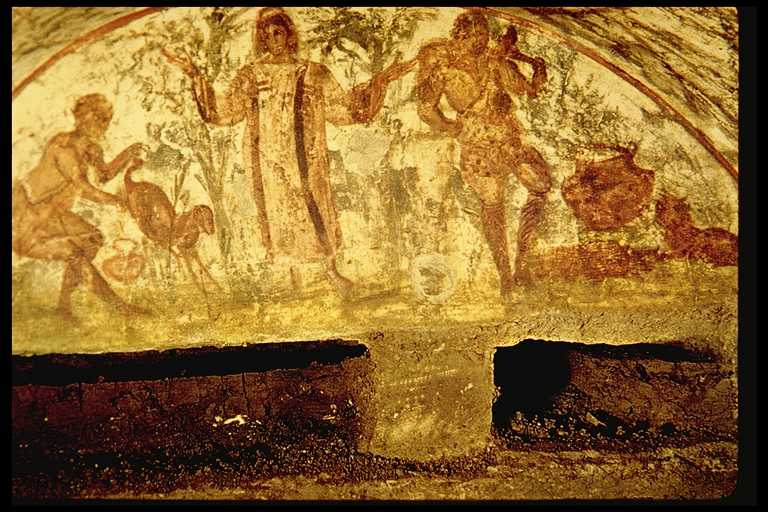 nd working on a paper on the orant, a motif in ancient Christian art. That's the orant over there on the left, taken from a 3rd century catacomb just outside of Rome. She's the one with her hands outstretched. To her left is the Good Shepherd, another early Christian motif.
nd working on a paper on the orant, a motif in ancient Christian art. That's the orant over there on the left, taken from a 3rd century catacomb just outside of Rome. She's the one with her hands outstretched. To her left is the Good Shepherd, another early Christian motif. The orant is important because it's the most common image in early Christian art. It's everywhere. (The Good Shepherd is the second most common). The orant (from the latin for "praying") has befuddled scholars and art historians for a long time. It's one of only two images in early Christian art (along with the Good Shepherd) that uses a human figure. It's almost always female, even when it depicts a male character like Noah. Its hands are always outstretched in a praying fashion.
There are lots of theories. Some people think it just means what it meant to the Romans--piety, or the personification of the deity Pietas. Some think it's evidence of a long-lost female priesthood, or goddess-worship in early Christianity. Some think it's just a woman praying, and some think it's an early example of the veneration of Mary.
goddess-worship in early Christianity. Some think it's just a woman praying, and some think it's an early example of the veneration of Mary.
 goddess-worship in early Christianity. Some think it's just a woman praying, and some think it's an early example of the veneration of Mary.
goddess-worship in early Christianity. Some think it's just a woman praying, and some think it's an early example of the veneration of Mary. My thesis is that the first option--personification of Pietas--is correct. The orant figure was common on coins in the imperial era, usually with a female figure from a royal family posing as the goddess Pietas. (The coin on the top is real; the bottom one is a replica). I think Christians used the figure of the orant in an effort to both blend in with broader Roman culture (and thus stay unnoticed) and to assert certain beliefs. This is the tricky part.
There's a guy named James Scott, who wrote about the "hidden transcript of the subordinate." Basically, he says, whenever one group is in charge and subjugates other groups, the group in charge demands that certain things be said about them--that they're benevolent and wise, etc. The subjugated group says those things because they don't want to die. But when they're in private, they say other things about the ruling group. I suggest that the orant is adapted from the Pietas symbol to blend in with the rest of Roman culture, but that in reality it stands in for the cross as a symbol of suffering and death. (There weren't crosses in this period of Christianity...they didn't come along until later). The outstretched arms of the orant mimic those of Jesus on the cross.
Two other little bits of info bolster this case. First, the orants show up mainly in two ways: as characters in biblical stories of conflict or danger (like the 3 men in the fiery furnace) or on funeral art like sarcophagi. I think that's because Christians wanted to connect the orant (i.e., Jesus) to suffering and death. The second bit of evidence: in two cases the orant actually has stigmata on its hands. That seems like a pretty clear indication that it recalled the crucifixion.
There's lots more to it, obviously. (The paper was 18 pages). But that's the gist of it. I'm looking forward to presenting it Tuesday and getting some feedback.
I have no idea why there are no paragraph divisions at the end, and nothing I do changes it. Oh well.
ReplyDelete